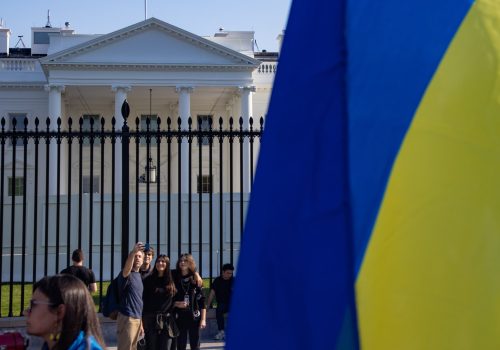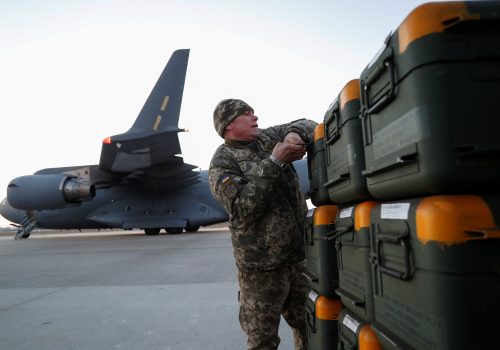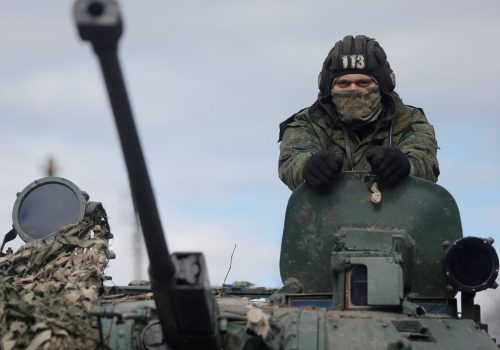FAST THINKING: The US arms Ukraine for the long haul. Is it enough?
JUST IN
They’re opening up the spigot. As US President Joe Biden requested a new $33 billion weapons and aid package for Ukraine on Thursday, Congress overwhelmingly approved a separate military-assistance program rooted in decades-old legislation that helped the United Kingdom battle the Nazis in its own hour of need. Taken together, the funding appeal and so-called Lend-Lease program—designed to clear the path for shipping more equipment to Ukraine—will send a clear message to Russia: The United States is serious about defending its partners. Our experts lend us their thoughts about the impact of these big moves.
TODAY’S EXPERT REACTION COURTESY OF
- Tyson Wetzel (@gorillawetzel): Senior US Air Force fellow at the Scowcroft Center
- Tom Warrick (@TomWarrickAC): Director of the Scowcroft Center’s Future of DHS Project and former senior official in the US departments of State and Homeland Security
- Melinda Haring (@melindaharing): Deputy director of the Eurasia Center
The nitty-gritty
- Biden’s $33 billion request more than doubles the funding Congress has already approved to help Ukraine in its war with Russia, and the ask includes everything from artillery and armored vehicles for Ukraine to a stronger US troop presence in nearby NATO countries and support for Ukrainian agribusiness during the fall harvest.
- “This announcement was the clearest indication yet that the US believes Ukraine can win this war,” Tyson says, and now Washington is “investing significant resources in helping the Ukrainians do just that.”
- Meanwhile, the Lend-Lease bill—which now goes to Biden’s desk for his all-but-certain signature—is light on details but will enshrine into US law support for security assistance to Ukraine and remove bureaucratic hurdles to sending the embattled country more equipment.
- The legislation means that “Ukrainian leaders and soldiers alike can plan their campaigns with the understanding that the United States will be ramping up to provide munitions and weapons systems that can match Russia’s larger and more capable forces,” Tom tells us. “Troops with assured resupply [of weapons and military equipment] are far more effective than troops who have to husband their ammunition.”
- All of which, in Melinda’s view, amounts to “good moves, but not great” ones, considering that the funding request is intended to only last through September and “does not include planes” while Lend-Lease is “largely symbolic.”
Subscribe to Fast Thinking email alerts
Sign up to receive rapid insight in your inbox from Atlantic Council experts on global events as they unfold.

Shaping the peace
- With Lend-Lease in place and more money likely to follow from Congress, the United States will now need to “ramp up production of Javelin anti-tank missiles and restart production of Stinger surface-to-air missiles,” Tom tells us. The race to resupply is on.
- The fight in Ukraine is turning into a war of attrition in the country’s eastern Donbas region. Tom says a potential peace deal will be shaped by more than where the lines of control shake out whenever both sides stop fighting. Any settlement will also be influenced by “the expectations of each side of how the war would likely go if it continued.” In that sense, he adds, “Lend-Lease fundamentally changes the expectations of the combatants and strengthens Ukraine’s hand against Putin in securing the peace that will follow.”
- Melinda argues that providing fighter jets to Ukraine—a tortured debate in Washington recently—would go a long way toward shaping those expectations. “If Washington and the West want to end the conflict as soon as possible, giving Ukraine all of the equipment it needs now, including planes, before Moscow steps up its Donbas offensive and aggressively targets Odesa, is key,” she says. “How many more Buchas will it take before we send planes?”
Moscow’s next moves
- Tyson expects Washington’s actions to “draw the ire of Moscow” but not its direct fire. “Despite the rhetoric, it is unlikely that Russia will take military action against the US or its allies and partners.”
- Why? Because “the Russians have their hands full in the Donbas and do not have the forces to begin an expedition against NATO,” he says.
- Russian President Vladimir Putin has not been shy about threatening to use nuclear weapons, but Tyson notes that “the US and NATO have already called this nuclear bluff” and continued sending arms to Ukraine well beyond what most countries were considering doing when the war began in February.
- “The Rubicon of lethal, offensive aid was crossed long ago with no Russian action,” Tyson says. “There is nothing in this package that is likely to drive the response Putin has been threatening for months.”
Further reading
Sun, Apr 24, 2022
Biden should deploy ‘great arsenal of democracy’ to defend Ukraine
Inflection Points By Frederick Kempe
Today, FDR's message to President Joe Biden would be: Do more now to stop Vladimir Putin.
Fri, Mar 11, 2022
Lend-Lease 2022: How the US can back Ukraine against Putin
UkraineAlert By Thomas S. Warrick
With Ukraine still in desperate need of more military aid to counter Vladimir Putin's invasion, it is now time for the United States to revive the Lend-Lease program signed into law eighty-one years ago on March 11, 1941.
Thu, Apr 21, 2022
Climbing the ladder: How the West can manage escalation in Ukraine and beyond
Report By Richard D. Hooker, Jr.
Russia’s invasion of Ukraine and NATO’s response increase the possibility of purposeful or inadvertent escalation in Europe. Understanding how these dynamics might impact the war and further degrade transatlantic stability is critical.
Image: Service members of the Ukrainian Armed Forces fire a Javelin anti-tank missile during drills at a training ground in an unknown location in Ukraine, in this handout picture released February 18, 2022. Ukrainian Joint Forces Operation Press Service/Handout via Reuters.


